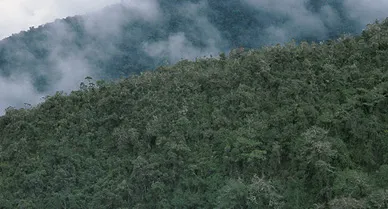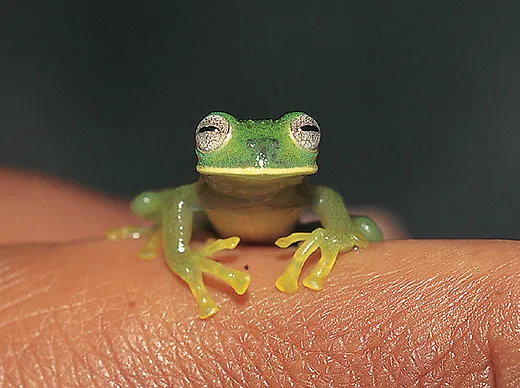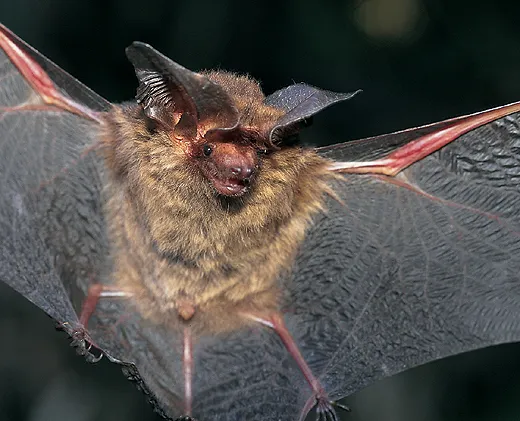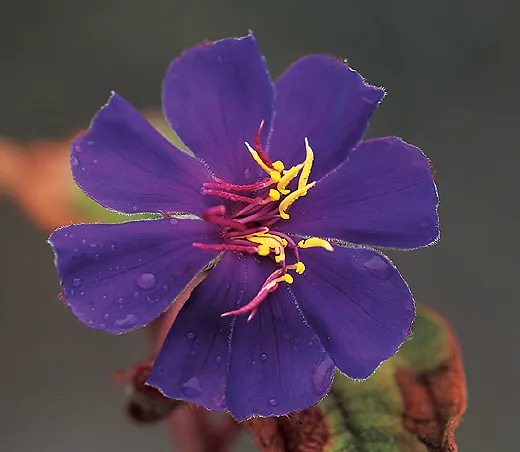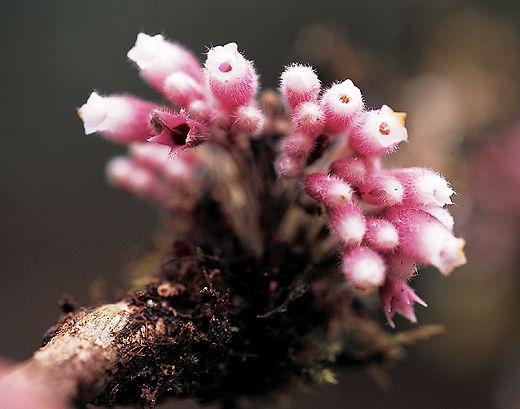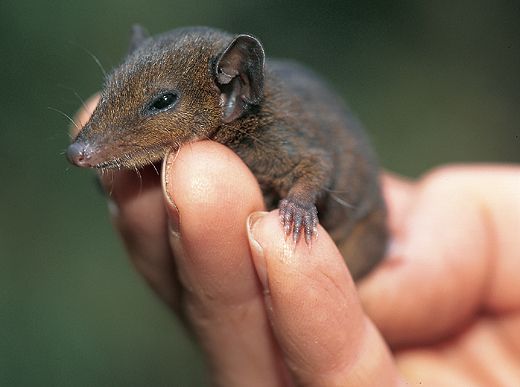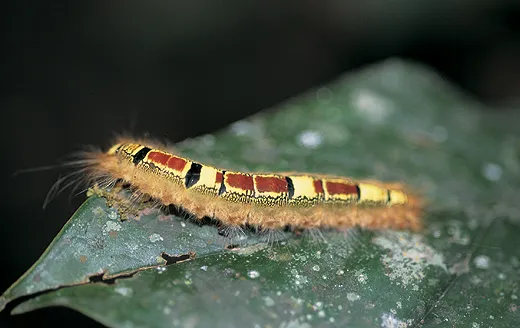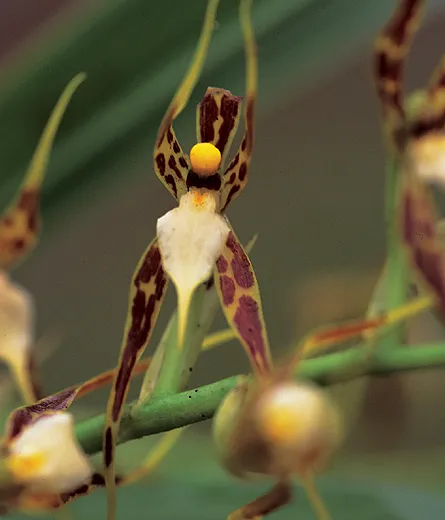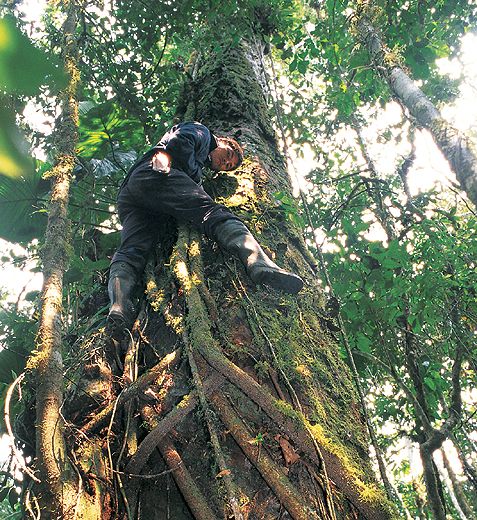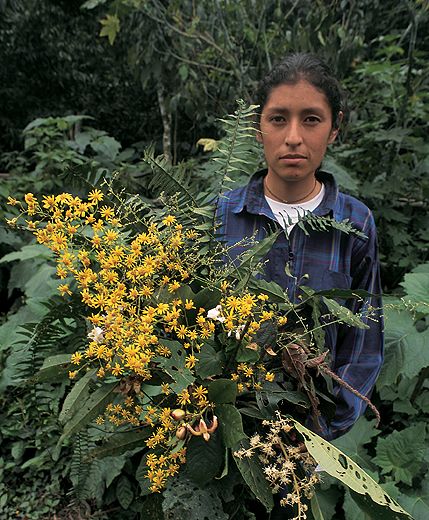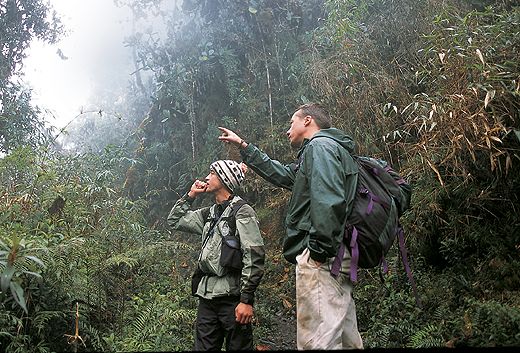Uphill Battle
As the climate warms in the cloud forests of the Andes, plants and animals must climb to higher, cooler elevations or die
On the crest of the eastern Andes, about an eight-hour drive on a dirt road from Cuzco, Peru, is an expansive vista of one of the most diverse forests on earth. Storm clouds boil up in the pink evening sky, and fog advances over the foothills. The rain and fog suffuse the mountains with the moisture that makes them so astonishingly full of life.
Miles Silman, a biologist from Wake Forest University in North Carolina, brought me to this ridge to introduce me to the cloud forests of Peru. Clouds born of moisture rising from the Amazon River Basin sustain a great variety of trees, which in turn support ferns, mosses, bromeliads and orchids that struggle to lay down roots on any bare patch of bark. It’s these epiphytes (“epi” means “on top of,” and “phyte” means “plant”), plus the wet humus soil, the thick understory of plants and the immersion in clouds, that distinguish cloud forests from other types.
Silman and other scientists are attempting to catalog and understand the plant and animal life in Andean cloud forests before it’s too late. Oil companies, having found petroleum and natural gas in the surrounding lands, are cutting roads and pipelines that scientists say are damaging some plant populations. Also, local farmers and ranchers clear cloud forest to expand their operations and harvest firewood.
Most significant, the cloud forests here are threatened by climate change. In other parts of the world, warmer temperatures in the past century have pushed native species toward the geographic poles or altered their seasonal growth and migration. In North America, for example, the ranges of the blue-winged warbler and other songbirds have shifted north; barn swallows and other birds are migrating earlier in the spring than they once did; and plants are blooming sooner. But cloud forests may be particularly vulnerable to climate change.
Of 25 biodiversity hot spots worldwide that conservation groups say deserve special protection, the tropical Andes is the richest by far, says biologist Lee Hannah of Conservation International. The region has almost twice as many plant species and four times as many endemic plants—native species found nowhere else in the world—as the next place on the list, the forests between central Mexico and the Panama Canal.
Many of the Andean plants have “shoestring distributions.” That is, the area where they can root, grow and reproduce stretches over hundreds of miles horizontally—but only hundreds of feet vertically. Says Silman, “I could stand upslope and throw a rock across the elevational range of many different species.” These plants’ preferred altitudes—and therefore the altitudes of the birds and other animals that feed on them, pollinate their flowers and disperse their seeds—are determined largely by temperature. And as the Andes heat up through global warming, these plants may be evicted from their natural homes.
I head toward the cloud forest with six biologists and one field assistant. We plan to hike about 75 miles round trip, gaining and losing 9,000 feet in elevation over passes approaching 13,000 feet. The first day, we climb from the Yavero River west to the summit of an unnamed mountain in Peru’s Manú National Park, one of the largest rain forest reserves on earth. Our goal is Callanga, a small valley in the heart of Manú. The initial pace of the hike has me breathing deeply, and I wonder if I will be able to keep up.
The Andes comprise high parallel ridges that follow the Pacific Coast of South America. In the north, these ridgelines can be moist on both sides, but in Peru, the western slopes are bone-dry and the eastern slopes are saturated by the mist and clouds. On the drive from Cuzco to our trail head, steep terraced farms covered the sides of these tall mountains like a mosaic. In the canyons between ridgelines the forest is mostly pine and eucalyptus, both introduced species. Farmers going back even before the Inca have removed much of the natural vegetation. Only when you get to the ridgeline next to the Amazon Basin, where we do our hiking, do native species start to dominate.
We reach the Manú Park outpost, above the tree line, just before sundown. In the morning we fill up on oatmeal and start down the other side of the mountain. Trudging toward the trees below, Silman points out that they are even farther down the mountain than they should be. For more than 5,000 years people have gathered firewood from this highest layer of vegetation and cleared the land for farming and grazing. The Inca, whose civilization flourished here from 600 to 500 years ago, were masters of terraced farming. Burning or harvesting trees is now prohibited in this national park, but enforcement on these isolated slopes is difficult. “We should be walking in forest,” says Silman, as we follow the muddy paths surrounded by low bunch grasses.
The trail descends into forest—and clouds. In places I can barely see the path in front of me for the fog. Everything drips. At 6,000 feet of altitude, forests get up to 20 feet of moisture a year from rain. Water from clouds may add another 5 to 20 feet. The moss, ferns, bromeliads and orchids that cover the tree limbs strip moisture from the clouds and hold it, acting as a giant sponge. At the same time, trees extend roots directly from their branches into the epiphytes, to steal moisture and nutrients. The forest is a massive twisted tangle of roots, trees and epiphytes, what Silman calls “stuff on top of stuff.” All of the water-swapping interactions among plants slow the flow of moisture as it makes its way downhill into the headwaters of the Amazon.
Scientists have described this type of forest as a nutrient-rich economy perched on a nutrient-poor substrate. The soils are acidic, cold and waterlogged. “It’s a bad place to be a root,” Silman says. As a result, he has found, most trees put on less than a millimeter of girth a year—about the thickness of a dime. That slow growth rate doesn’t portend well for the ability of cloud forests to respond to rapidly changing climatic conditions, says Silman.
We trudge down the soggy trail. At one point it opens into a wide bog covered with deep sphagnum moss. Silman takes a detour in search of a new plant, but suddenly his leg disappears into a sinkhole. He pulls it out and backtracks to firmer ground. I stay on the trail. The biologists have their binoculars out frequently, to glimpse birds flitting by. Cloud forest is so dense that most wildlife encounters are brief. Still, the scientists spot mountain-tanagers, foliage-gleaners, spinetails and antpittas. The bird population goes up as we go down. The tropical Andes harbors 1,724 species of birds—more than double the number in Canada and the United States combined.
Josh Rapp, a forest canopy biologist at Wake Forest, is one of the daredevils of our group. He uses a slingshot to shoot a small lead weight attached to fishing line over a high limb. He uses the fishing line to haul up stronger string, and the stronger string to haul up his climbing ropes. He secures the rope to a branch of the 120-foot-tall tree, dons his helmet and inches up the rope. “There’s just so much more variety, multiple layers, and varied structures up there than you get in a temperate forest,” he says. “And all this variety translates into some amazing habitats for epiphytes. There’s big tank bromeliads shooting up red stocks with multiple yellow flowers, and big clusters of pink orchids. It’s incredible.” The epiphytes may be particularly susceptible to climate change if the cloud level rises.
William Farfan, a biologist from the University of Cuzco, brings me a small orchid not much bigger than his thumb. “Look at that,” he beams. “Isn’t she beautiful?” Indeed, the tiny purple, yellow and ivory blossom is dazzling. Karina Garcia, another biologist from the University of Cuzco, demonstrates her collecting prowess with a bunch of blossoms that trail to the ground like an enormous wild bridal bouquet. The Peruvians on our expedition compete with each other to capture the rarest and most elegant treasures from the forest; so far, she’s ahead.
Collecting specimens may sound a bit old-fashioned, but paleoecologist Mark Bush of the Florida Institute of Technology, who studies the ancient history of these cloud forests, says scientists are still trying to pin down what lives here.
Work continues throughout the week. The biologists attach bands to trees to measure growth rates, collect specimens and stake out plots they will visit later to monitor changes in the forest in response to climate change. We are not without visitors. A troop of woolly monkeys swings through the canopy, hanging onto limbs that seem barely able to hold their weight, and leaping across chasms. One morning Silman spots a pair of prehensile-tailed porcupines in the canopy that he says are harder to find than jaguars in this part of the world.
Many animals here have evolved close relationships to specific types of plants. In the dense, relatively windless cloud forest, birds and insects do most of the pollinating. Sword-billed hummingbirds, with bills longer than their bodies, feed on flowers with long tubular blossoms. Sicklebill hummingbirds have shorter bills that have an almost 90 degree bend, allowing the bills to fit into similarly bent flowers of the genus Heliconia. “There are more than 200 species of hummingbirds in South America,” says Cristián Samper, director of the Smithsonian’s National Museum of Natural History, “and every one of them has a story like that.”
In previous trips, Silman and Bush have hauled in, by mule and backpack, pontoon platforms that they float on lakes in the cloud forest. They lower a hollow drill from a miniature derrick into lake bottoms to gather three-foot-long plugs of sediment. These core samples are sent to Bush’s lab in Melbourne, Florida, for analysis. The distribution of pollen in the layers of sediment offers clues to how life in the region changed in response to the last ice age.
At Lake Consuelo, near the lower limit of the cloud forest, the researchers created a sedimentary record extending back 43,000 years. Comparing their data with different sediments analyzed by other scientists, Bush and Silman believe that during the last ice age, which lasted from about 105,000 to 11,000 years ago, when temperatures fell by 9 to 16 degrees Fahrenheit in this area, species moved down from the mountains into the Amazon Basin. “Basically, the tropical forests had a much more tolerable climate for allowing species to survive,” says Bush. “The lack of enormous ice sheets moving across the land, as happened in North America, prevented the wholesale extinctions that occurred in the north.” As the earth began to warm up about 19,000 years ago, species moved back up into the Andes—but at a very slow pace.
Based on that picture of the past, Silman and Bush think that these slow-growing cloud forests may not be able to keep up with the rapid climate change predicted for this century. They and other scientists say plants won’t be able to adapt fast enough to survive in their current ranges. Trees in particular may have to move to higher elevations in just one or two generations. But no one knows whether they will flourish upslope, where the land is steeper and the soils have different chemistry, depths and microbes.
“Plants are going to have to migrate on average 2,600 feet to remain in equilibrium with climate,” says Silman. “That’s a long way, and they have to get there by 2100.” By then, according to most climate experts’ predictions, the average temperature in the cloud forest will increase by four to seven degrees Fahrenheit.
Much of the information about the effect of changing climate on high-altitude forests doesn’t come from the Andes, which have been relatively little studied, but from Costa Rica. There, in the Monteverde cloud forest, the dry seasons have become longer since the mid-1970s and have coincided with a number of local extinctions. Researchers recently tied the widespread extinctions of endemic frog and toad species in Monteverde to climate change. Warming in the next century is predicted to move the base of the cloud forest in that part of Costa Rica about 1,000 feet upward. If the movement continues, the clouds may rise above the crest of the Cordillera de Tilaran, and the cloud forest will cease to exist.
At camp, University of Cuzco biol-ogists Mireya Raurau and Marlene Mamani press plant cuttings between sheets of newspaper. The pressing continues into the night. Much of the load will be shipped to specialists in Peru and herbariums around the world where botanists will attempt to tag known plant species and identify new ones. Silman has thus far found dozens of new plant species, a new genus of tree, and some major extensions of the ranges of known species.
The Peruvian researchers will stay here for a month. For our entire stay in the Callanga valley, I’ve been staring up wearily at a 9,100-foot ascent—the first stretch of the way back out. Rapp and Silman plan to do the entire hike, a distance of 30 miles, in a single day starting at 2 in the morning. I decide to leave a day earlier, on a more civilized schedule.
Silman arranges a mule and guides for my journey. Ten-year-old Tito and his 18-year-old sister-in-law Malta belong to a mule-driving family in Callanga. They hike this 30-mile trail for a living, taking the valley farmers’ goods to market. Malta has a load over her shoulder, which I assume is clothes or food. Then the bundle begins to cry. On the way up, Malta nurses the baby, holding him in her left arm while whipping the mule with a stick held in her right hand. With all of us shouting, whipping and pushing, the mule goes only five to ten feet before it stops and we have to repeat the whole process. Our ascent travels the same upward path that the cloud forest may have to take.
Silman and Rapp, bleary-eyed, catch up with us the next day. Silman says hello, then collapses spread-eagle on the ground. After a brief rest, we resume our trek out of the cloud forest. On the hills above, a farmer is burning forest to make way for crops. Satellite photos taken over South America have shown 6,000 fires burning in tropical forests in a single night. “You can’t stop them all,” says Silman.
Michael Tennesen, a writer and photographer based in Lomita, California, wrote about a 19th-century family of telescope builders in the October 2001 issue of Smithsonian.
